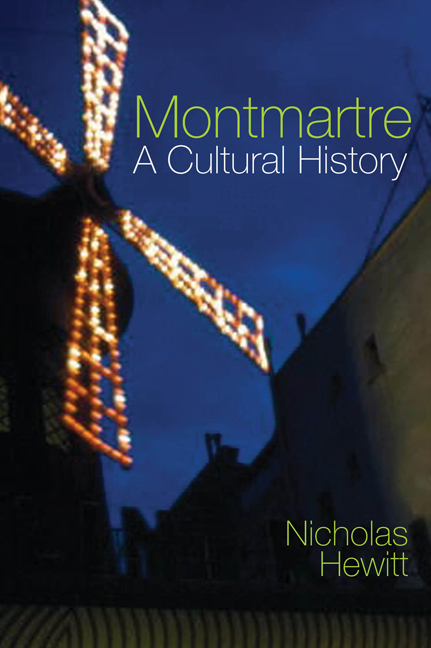Book contents
- Frontmatter
- Dedication
- Contents
- List of Illustrations
- Acknowledgements
- Map
- Introduction
- 1 ‘Montons à la Barrière’
- 2 The Artistic Cabarets
- 3 Music Halls and Mass Culture
- 4 Theatre and the Avant-Garde
- 5 The Bateau-Lavoir and the Lapin Agile
- 6 Wartime and the Années Folles
- 7 The Place of Memory
- 8 The Ecole de Montmartre
- 9 The Occupation: Céline and Aymé
- Epilogue: Montmartre on Film
- Bibliography
- Index
- Plate section
2 - The Artistic Cabarets
- Frontmatter
- Dedication
- Contents
- List of Illustrations
- Acknowledgements
- Map
- Introduction
- 1 ‘Montons à la Barrière’
- 2 The Artistic Cabarets
- 3 Music Halls and Mass Culture
- 4 Theatre and the Avant-Garde
- 5 The Bateau-Lavoir and the Lapin Agile
- 6 Wartime and the Années Folles
- 7 The Place of Memory
- 8 The Ecole de Montmartre
- 9 The Occupation: Céline and Aymé
- Epilogue: Montmartre on Film
- Bibliography
- Index
- Plate section
Summary
Le Chat Noir
‘What is Montmartre? – Nothing! What must it be? – Everything!’ So Rodolphe Salis, self-styled ‘gentleman-cabaret-owner’, began his address to the voters of the eighteenth arrondissement of Paris in the 1884 parliamentary elections. At the same time, he boasted:
God created the world.
Napoleon created the Légion d'Honneur.
I made Montmartre.
There was more than a little truth in Salis's claims. In the last two decades of the nineteenth century, Montmartre achieved a pre-eminent position in both the high and popular culture of the capital, a feat due almost exclusively to Salis and the establishment he founded in 1881, the artistic cabaret Le Chat Noir. As the catalogue to the establishment's centenary exhibition commented:
At the foot of the hill of Montmartre, in a quarter that was in full bloom and where artists, writers and young people wished to live more and more, in November 1881 Rodolphe Salis opened Le Chat Noir, a cabaret of a completely new sort, derived from the political, literary and artistic café.
Salis had come from his native Picardy to Paris with ambitions to be a painter, but had failed to make his fortune. Bowing to paternal pressure to settle down, he married and, in 1880, set up a studio selling religious paintings in the premises of a former post office at 84 Boulevard Rochechouart. The following year, in the Grande Pinte, on the Avenue Trudaine, he met the Left Bank bohemian Emile Goudeau, the founder of the Club des Hydropathes, and persuaded him to organise a goguette in his studio. A goguette was a combination of a social evening with a more formal entertainment element, in which participants sang songs, declaimed monologues or recited from their literary work. Its origins go back to the ‘Bock Dinners’ inspired by Manet's Le Bon Bock, which began in 1875, and which led to the establishment of the Brasserie du Bon Bock in the Rue Dancourt in Montmartre in 1879, but it also rapidly became an important feature of Left Bank culture, associated particularly with the Club des Hydropathes. It was in 1878 that Goudeau established his club at 7 Rue Racine, based initially on the simple formula of poets reciting their verse for fellow writers, a formula which quickly attracted chansonniers like Mac-Nab and Jules Jouy from other Left Bank goguettes.
- Type
- Chapter
- Information
- MontmartreA Cultural History, pp. 35 - 63Publisher: Liverpool University PressPrint publication year: 2017



